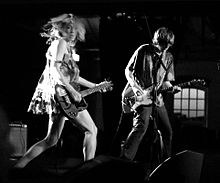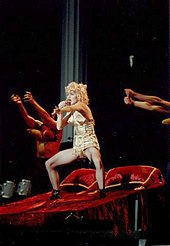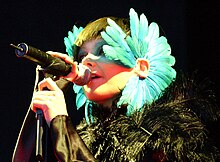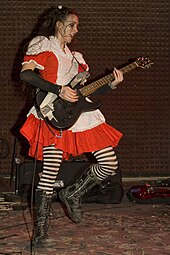Girlie
Girlie describes a media phenomenon and a fashion of the 1990s that was shaped by the fact that adult women, rejecting the prevailing image of women, appropriated clothing and accessories produced for young girls. Girlie is rather - in contrast to Raverin or Riot Grrrl - rarely a figure of identification or self-designation, but often an external attribution that was mostly transported and formed via the media. The word girlie can also be used to describe a young, girlish and unconventionally dressed woman who appears self-confident, sometimes also cheeky and provocative. The emergence of girlie is closely linked to the formation and becoming known of the Riot Grrrl movement , a post-feminist music alternative movement within the punk and grunge scene . The Riot Grrrls set strong impulses in changing the image of women, which, transported by the media and picked up by trend scouts, were slimmed down to girlie by means of new female pop stars and their feminist content was largely discarded. The girlie fashion was transported via youth television channels such as MTV or VIVA2 , in which protagonists such as Heike Makatsch , Charlotte Roche and others. a. were active as moderators to shape the style. Girlie has a wide range - supporters of subcultural music scenes such as alternative and techno adapted the girlie style for themselves as well as female fans of girl groups of this time, which can be assigned to the commercial mainstream .
term

The term originally comes from English, came up there in the 1990s and is called "Girly Girl", but was adopted in German as "Girlie". The term was first described as a word in a German dictionary in 1995 by Schönfeld. Occasionally, the spelling Görlie appeared based on Gör (e) .
The occurrence of the Girlie mode correlated with the advent of the mainstream successful girl bands and Girlie -Solokünstlerinnen whose audience was almost exclusively a female. These conveyed more adapted images of femininity in a girlie look. However , the young women of the 1990s, known as girlies , represented a wide range of attitudes. The author and musician Kerstin Grether describes Girlie as a media attribution based on purely external characteristics, the meaning of which for women themselves has been misinterpreted by the media: "Inspired by the rocking Riot-Grrrl movement , we made it clear that the" girlies "are to be delivered whom the media recently counted all young women shouldn't lump together. Because for us ... artificial eyelashes and real emancipation were never mutually exclusive. " Feminist-minded young women, who may also be close to the techno or punk subcultures , made use of similar outward appearances, but gave them a different meaning: With their girl's clothes, they set themselves apart from the prevailing standard, from the image of the adult woman.
Girlie as a fashion style
The girlie style developed in isolation and as a break with the then current image of women. He is u. a. characterized by clothing and shoes that allow more freedom of movement and have partly been adopted from the sports sector into everyday or stage fashion.
The tops were short to cropped, tight T-shirts (“the kidneys are peeping out”), in summer also in the shape of tops with spaghetti straps. Since then, T-shirts have been produced using the girl cut , i.e. adapted to the female body shape and in contrast to the straight-cut T-shirt shape of the 80s. T-shirts - especially in the techno scene - were printed with the then new technology of photo printing. For the first time, bikini tops or sports bras were worn as sole tops in public spaces, which were then called bustiers .
In addition, slightly flared mini skirts were worn, which in the cool season were not combined with nylon tights, which were then rejected as ladylike, but with opaque tights with colorful rings or otherwise strongly patterned. Tight short trousers such as B. worn cycling shorts or leggings.
Dresses were mostly mini dresses or hanging dresses made of T-shirt fabric. They were monochrome or striped, with floral patterns or, in rarer cases, with color gradients or psychedelic patterns that were based on fabric patterns from the 60s and 70s. Sometimes old petticoats were worn as dresses or they were light and lace-like underwear, as Courtney Love often wore.
Second-hand training jackets from the 70s, jogging pants, etc. a. Retro sportswear made its way into everyday fashion.
Jeans were worn in the wide-cut baggy pant format , especially by rap fans. In addition, were flares popular, especially in the wide variation that extends from the buttocks down from continuously - the so-called flared trousers . In the techno sector, these had flashy patterns, made of nylon or plush . Pants were worn on the hips.
Jackets were short and made of synthetic fur with cowhide, leopard, zebra and tiger patterns. Black short leather jackets with zippers were also possible.
The color scheme of the girlie clothing ranged from the so-called candy colors to neon colors : pink, orange, turquoise, purple, lime green. Elastic fabrics were worn that were printed with radially symmetrical flowers with a yellow center (margarites). Typical were z. B. bright green fabric with white daisies. Prints with smileys and peace signs were also popular .
The shoes were mostly bulky and consisted of platform sneakers (Buffalo) or 70s retro platform sandals, in the subcultural area of lace-up boots ( Doc Martens ) or basketball shoes ( Chucks ). The usual combination of heavy, chunky shoes or sports shoes with short dresses was initially perceived as a refraction, as unconventional and unusual. The Riot Grrrls deconstructed u. a. thus their sexualization as women or girls.
Stylized flowers in all variations were worn as jewelry - as earrings, on chains, etc. a. A taboo was broken by metal or colored plastic piercings on the nose, eyebrows , lips , tongue or navel, as well as tattoos , mostly tribals. During this time the so-called ass antlers were also created .
In contrast to the previously ubiquitous perm, straight hair was worn. So-called "rat tails" came into vogue as hairstyles - two pigtails diagonally behind or diagonally above the ears, also as a bun variant, which were previously unbearable for adult women as it was considered a children's hairstyle . The ponytail was also very common. When a pony was worn, it was cut very short. Hair ties with flowers and hair clips in bright colors or glittering, which were originally produced for children, were used as accessories. Braided Rasta braids were also worn. Women with shorter hair wore a layered and teased bob hairstyle at the back of the head , possibly with a zigzag parting or other creative parting shapes . Girlies (punk and techno) who were subculturally located, colored their hair with unnaturally bright colors such as blue, green, purple or bright red.
The make-up could be subtle or flashy with red lipstick or futuristic with black lipstick and silver eyeshadow. Marusha, with her green eyebrows , also set the tone . The Riot Grrrls used eye-catching make-up such as B. red lipstick, not to cover up alleged "blemishes", but to emphasize areas of the body with sexual connotations. In doing so, they emphasized female sexualization and moved away from a "feminine naturalness". When they wore smeared make-up, they represented "disorganization" and "traces of aesthetic decay", pointed to violent relationships or opposed the "need to be clean and neat".
Girlie movement
Girlie was not a joint formation in the sense of a movement , since its protagonists pursued very different and - from punkers to ravers to pop stars - opposing goals and interests. Girlie is not to be seen as a figure of identification, but rather as a media phenomenon whose origin was a movement - the feminist Riot-Grrrl-Movement . This arose within the punk and hardcore scene or together with the grunge scene. The rejection of, the break with and the postmodern play with existing female role models have in common the riot grrrl movement and girlie . At Riot Grrrl , this break has a clearly politico-militant component - it's about the struggle for equality. In Girlie it comes to matters of style, hipness and identity by consuming the "right" clothes. While the Riot Grrrl made its own clothes under the slogan "do it yourself", the girlie was the courted customer in the corresponding market trend, which is increasingly exerting influence on the goods and media world.
Forerunners in style and demeanor for the Riot Grrrls were Kim Gordon , Deborah Harry, and in some ways Madonna . They are between 10 and 20 years older than most riot grrrl and girlie protagonists. Madonna was hailed by sex-positive feminists of the third wave of feminism such as Camille Paglia as an avant-garde who is shaping a new image of women: She has control over her life, over her sexuality, over her artistic output and is economically successful.
The riot grrrls that provided essential impulses for girlie were Kathleen Hanna with Bikini Kill as well as bands like Babes In Toyland , Bratmobile , Sleater-Kinney , L7 and Team Dresch . In Germany, the Bride in the Eye , the Mobylettes , the Lassie Singers , Parole Trixi and the Lemonbabies were among them. In Germany, MTV and VIVA2 were widely used in the media in addition to the above. American riot grrrl bands people like grunge pioneer Courtney Love , who anticipated aspects of girlie fashion and initially combined them with a radical rejection of hegemonic femininity. This was not only expressed in her clothing style, but also in her inappropriate, sometimes obscene behavior, with her work as a guitarist or the publicly visible drug and alcohol consumption. Björk and Gwen Stefani , who came from the subcultural field and became commercially successful in the 90s, transported and spread girlie fashion in connection with female self-determined success in the pop business. Gwen Stefani has also worked as a fashion designer since then.
The girlie or the girl power movement represents the subsequently defused and commercialized variant of the parallel existing riot grrrl movement. The girlie cult with girl bands and pop singers such as the Spice Girls and later Britney Spears became particularly popular in the music sector , the Pussycat Dolls , Christina Aguilera , the German No Angels , Blümchen , Tic Tac Toe and Lucilectric . Of the feminist demands of the riot grrrls, the rebellious element that remains is sexual self-determination - initiating sex with men, as expressed in the song "Because I am a girl" by Lucilectric. Nevertheless, the leeway is limited, the girlie image of women contains restrictions and disciplines despite the greater scope for action.
The fact that girlie was able to spread widely as a media phenomenon was also due to the popular youth TV channels MTV and VIVA2 in the 1990s . People perceived as girlie, such as Heike Makatsch , Kristiane Backer , Enie van de Meiklokjes and Charlotte Roche, worked as video jockeys and music journalists.
Films that picked up on and distributed girlie were Burning Life (with Maria Schrader and Anna Thalbach, Germany 1994), Tank Girl (with Lori Petty, USA 1995) and Lola rennt (with Franka Potente , Germany 1998).
Girlie and feminism
From the point of view of second-generation feminists like Alice Schwarzer , the girlie phenomenon represents a step backwards - it promotes consumer and pleasure-oriented femininity without critically opposing discrimination. The girlie is once again becoming an accomplice of structures discriminating against women in a patriarchal system and is thus on a par with the generations of women before the emancipation movement. The sociopolitical and socially disinterested girlies only pursued the permitted emancipation , and their revolt was a sham revolt that renounced the possibility of change. In any case, the consumer and pleasure-oriented trend for women and girls represents a radical departure from the feminist values of the 1970s. What is striking is the time lag of 20 years that prompted Spiegel to write about “Emma’s daughter” and the Replace years of feminism with a new type of woman.
The second generation feminists were unable to perceive and appreciate the approaching third wave of feminism around 1990. Angela McRobbie sees the girlie culture like its feminist critics in the context of a “generation-specific antagonism”, i.e. a typical generation conflict through the introduction of contrary values in the younger generation, and believes that this problem has the effect that from the feminist perspective of the mothers Force of this movement would be underestimated. It is precisely this male, sloppy and, conversely, sexist behavior of girlies that is a sign of a completed, irreversible social change.
Girlie and much more Riot Grrrl represent post-feminism, strongly influenced by pop culture, feminism of the 3rd wave. There is a natural way of dealing with the successes of second wave feminism, such as formal equality between men and women. The gender roles have become more fragile and permeable, there is more room for maneuver for young women. Girlie - also as a marketing strategy - combines male and female connotations (eroticism, self-confidence, independence, free from constraints, fun) and represents a more modern image of women as a means of identification. Yet men are still dominant.
Girlie protagonists
The list includes some women or bands who have become relevant in the media as role models in the sense of girlie fashion or the girlie lifestyle.
In the techno and dance area
- Bjork
- Marusha
- Luci van Org
- Flower (heart to heart)
- Aqua (Barbie Girl)
In the subcultural alternative area
- Kathleen Hanna , Kathi Wilcox, Tobi Vail from Bikini Kill (Rebel Girl)
- Gwen Stefani from No Doubt (Just a Girl and Hollaback Girl)
- Courtney Love , Melissa Auf der Maur , Kristen Pfaff , Samantha Maloney u. a. (Violet) from Hole
- Courtney Love, Jennifer Finch and Kat Bjelland from Sugar Baby Doll
- Kat Bjelland, Lori Barbero, Michelle Leon from Babes In Toyland
- Corin Tucker, Carrie Brownstein, Janet Weiss from Sleater-Kinney
- Jennifer Finch, Suzi Gardner, Donita Sparks from L7
- Donna Dresch, Jody Bleyle, Kaia Wilson, Marci Martinez, Melissa York from Team Dresch
- The Breeders with Kim Deal from the Pixies and Tanya Donelly from the Throwing Muses
- Justine Frischmann , Annie Holland and Donna Matthews from Elastica (Waking Up)
- Lætitia Sadier and Mary Hansen from Stereolab (French Disco)
- D'arcy Wretzky of the Smashing Pumpkins
- Kira Roessler from Black Flag
- Bernadette La Hengst , Peta Devlin , Karen Dennig, Katja Böhm, Barbara Haß from The bride skin into the eye (man with a tendency to depression)
- Christiane Rösinger , Almut Klotz , Funny van Dannen , Britta Neander , Kathrin von Witzleben from the Lassie Singers (male fellow human beings)
- Sandra Grether, Almut Klotz, Christine Schulz, Cordula Ditz, Sandra Zettpunkt , Jule Kruschke from Parole Trixi (Greetings) : “Greetings, young women of today / I hope you will regret it at some point / if everything you see / only still consists of clichés. "
- Diane Weigmann , Julia Gehrmann, Gina V. D'Orio , Lina van de Mars u. a. from the lemon babies
- Kerstin Grether , journalist and writer
In the commercial pop area
- Lucilectric (girl)
- Tic Tac Toe
- Spice Girls
- Christina Aguilera
- Britney Spears
- No Angels
- Pussycat Dolls
VJs, TV presenters and actresses
- Kristiane Backer , 1989–1995 VJ on MTV for the programs Coca-Cola Report , European Top 20 and Awake on the Wild Side , 1993–1995 television program Bravo TV on RTL II , 1996–1998 on NBC Europe's cultural program The Ticket
- Heike Makatsch , with VIVA since 1993 with the programs Interaktiv and Heike Hausbesuch , 1995–1996 presenter on Bravo TV and RTL II , until 1997 heike Makatsch Show on RTL II, film actress
- Charlotte Roche , VJ with VIVA Zwei since 1998 with the program Fast Forward , referred to as “Queen of German Pop Television” with an idiosyncratic interview style
- Marusha , radio presenter, since 1990 with her techno show Dancehall on DT64 and later on Rockradio B , later under the name Rave Satellite , TV presenter on the show Feuerreiter on the RBB
- Tanja Mairhofer , VJ at MTV and VIVA Zwei , broadcast 2Rock , film actress
- Enie van de Meiklokjes , VJ since 1996 with VIVA, 1999–2001 with Bravo TV on RTL 2
- Franka Potente , film actress
See also
literature
- Wilfried Breyvogel: An Introduction to Youth Cultures . VS Verlag, 2005, ISBN 3-8100-3540-8 .
- Dieter Herberg, Michael Kinne, Doris Steffens: New vocabulary. Neologisms of the 90s in German . In: Writings of the Institute for German Language . Walter de Gruyter, Berlin 2004, ISBN 3-11-017750-1 .
- Angela McRobbie: Muscle Packs and Dicks. The importance of the girlie culture . In: Anette Baldauf, Katharina Weingartner (Eds.): Lips Tits Hips Power? Pop culture and feminism . Folio, Vienna, Bozen, ISBN 3-85256-077-2 .
- Katja Kailer, Anja Bierbaum: Girlism - Feminism between subversion and sellout . logos Verlag, Berlin 2002.
- Katja Kauer: Pop Feminism! Question mark! An introduction . Frank & Timme, Berlin 2009, ISBN 978-3-86596-245-4 .
- Gabriele Rohmann: Girls in Youth Cultures . In: Dornbirn conference . January 9, 2008, p. 6th f . (koje.at [accessed on March 26, 2008]).
- Eike Schönfeld: everything is easy. A dictionary of the New German . 3. Edition. CH Beck, 1995, ISBN 3-406-39226-1 .
- Gabriele Steckmeister: accomplices . In: Peter Heinrich Jochen Schulz to Wiesch (Hrsg.): Dictionary of micropolitics . VS Verlag, 1998, ISBN 3-8100-2013-3 , p. 135-136 .
- Angela Volkmann: Eva where are you? The gender perspective in religious education using the example of a religious book analysis on biblical topics . Königshausen & Neumann, 2004, ISBN 3-8260-2641-1 .
Individual evidence
- ↑ a b c d e f g h i j k Katja Kauer: Pop feminism! Question mark! An introduction. Berlin 2009
- ↑ a b c d e f Professorship for women's studies at the University of Potsdam (ed.): Film women - Zeitzeichen Women images in film of the 40s, 60s and 90s - diva, worker, girlie. Volume III: Girlie. in: Potsdam studies on women and gender studies. 1st year, issue No. 3/1997, 2nd improved edition February 1998.
- ^ A b Dieter Herberg, Michael Kinne, Doris Steffens: New vocabulary. Neologisms of the 90s in German . In: Writings of the Institute for German Language . Walter de Gruyter, Berlin 2004, ISBN 3-11-017750-1 , p. 140 .
- ↑ Is Bonnie Strange following Gwen Stefani? The it girl's hair is now blue! In: OK! , July 29, 2013
- ↑ Gabriele Rohmann: Page no longer available , search in web archives: Girls in youth cultures . In: Dornbirn conference . January 9, 2008, p. 6th f . (koje.at [accessed on March 26, 2008]).
- ↑ Kim Gordon Chats With Kathleen Hanna: Uncut Version! In: Bust Magazine, October / November 2013
- ↑ Camille Paglia: Madonna - Finally, a Real Feminist. In: New York Times , December 14, 1990
- ↑ Gabriele Steckmeister: accomplices . In: Peter Heinrich Jochen Schulz to Wiesch (Hrsg.): Dictionary of micropolitics . VS Verlag, 1998, ISBN 3-8100-2013-3 , p. 135-136 .
- ↑ Angela Volkmann: Eva where are you? The gender perspective in religious education using the example of a religious book analysis on biblical topics . Königshausen & Neumann, 2004, ISBN 3-8260-2641-1 , p. 65 .
- ↑ Dieter Herberg, Michael Kinne, Doris Steffens: New vocabulary. Neologisms of the 90s in German . In: Writings of the Institute for German Language . Walter de Gruyter, Berlin 2004, ISBN 3-11-017750-1 , p. 141 .
- ↑ Angela McRobbie: Muscle Packs and Tails. The importance of the girlie culture . In: Anette Baldauf, Katharina Weingartner (Eds.): Lips Tits Hips Power? Pop culture and feminism . Folio, Vienna, Bozen, ISBN 3-85256-077-2 , pp. 278 .
- ↑ Parole Trixi: Greetings! With introduction by Charlotte Roche, in: Youtube-Kanal von RIOTTRIXI, uploaded on October 14, 2011
- ↑ What are you looking at? - How multicultural is our everyday television life. (No longer available online.) JFC Media Center Cologne, archived from the original on April 28, 2005 ; Retrieved June 28, 2012 (p. 12). Info: The archive link was inserted automatically and has not yet been checked. Please check the original and archive link according to the instructions and then remove this notice.
- ↑ Bulante: Quickie with the vacuum cleaner. (No longer available online.) NEON , May 2, 2005, archived from the original on July 14, 2014 ; Retrieved June 28, 2012 . Info: The archive link was inserted automatically and has not yet been checked. Please check the original and archive link according to the instructions and then remove this notice.
- ↑ 1994 Feuerreiter Mayday, Feuerreiter broadcast with Marusha in the 90s, in: YouTube channel by sven1601, uploaded on February 21, 2014











